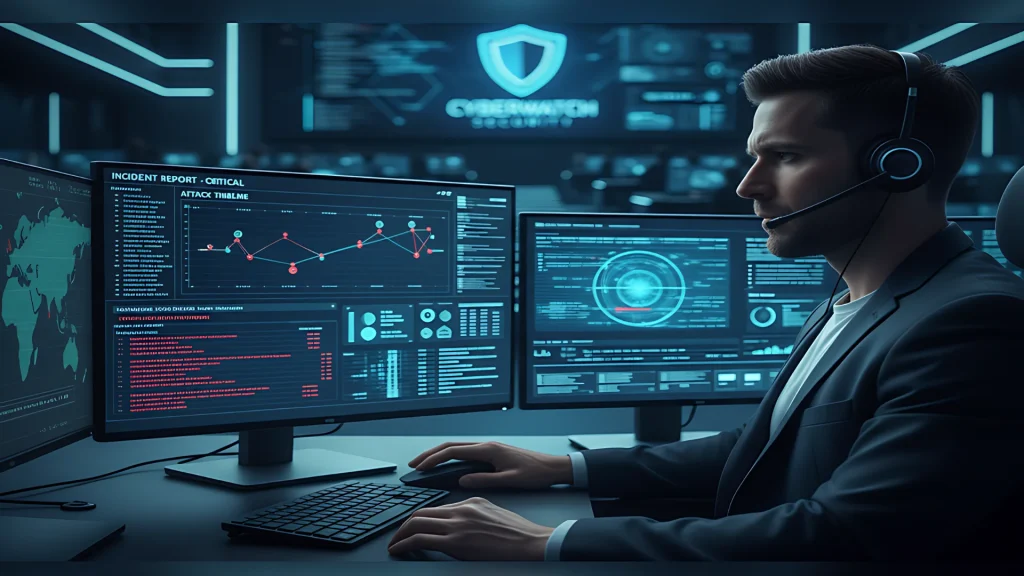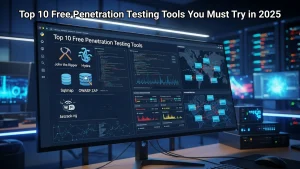Ever wondered what’s happening behind those blinking dashboards and scrolling logs? Meet the SOC Analyst—the person who turns a sea of telemetry into fast, confident action. In a modern Security Operations Center (SOC), the SOC Analyst blends pattern recognition with disciplined process: investigating signals, coordinating response, and feeding lessons back into the system so the next incident is handled even better than the last.
Blue Team Analyst Core Functions of a SOC Team
SOC Analyst Responsibilities
At its core, the role mixes curiosity with rigor. A Security Operations Analyst spends much of the day (and sometimes the night) watching the pulse of the environment—SIEM alerts, EDR detections, NDR anomalies, identity events, and cloud activity. The first job is triage: separate urgent truth from background noise so critical incidents get attention in minutes, not hours.
Once a lead is real, the SOC Analyst shifts into investigation. Think timeline building: which process spawned which child, which user logged in from where, and what data moved when. With enough context, the right containment move becomes clear—maybe isolate a host, block a hash, revoke tokens, or disable an account. After the fire is out, eradication and recovery remove persistence, patch systems, and bring services back safely. Finally comes the write-up: what happened, why it mattered, how long it took, and how to make it easier next time.
Monitoring & Triage in Practice
Set clear SLOs (e.g., Sev-1 triage ≤ 15 minutes). Let asset criticality guide priority. Automate enrichment—WHOIS, sandbox verdicts, geo-IP, identity risk—so every alert opens with context, not question marks.
Threat Hunting Methods for SOC Analysts

Start with a hypothesis: “We’re seeing MFA fatigue—could there be impossible travel and token abuse?” Then pivot through rare command lines, suspicious parent/child chains, and unusual destinations. The best hunts end as new, tuned detections.
Investigation & Containment Techniques
Build a minute-by-minute event chain. Choose the least-disruptive containment that actually stops risk: token revocation → account disable → host isolation → egress blocks. Document the “why” behind each step.
Eradication & Recovery Checklist
Remove persistence (run keys, WMI, services, scheduled tasks). Rotate secrets, patch the exploited service, and watch closely for 7–14 days to catch re-infection early.
Reporting & Continuous Improvement
Capture root cause, dwell time, and control gaps. Update rules, suppression logic, and playbooks. Include sample queries and a plain-language executive summary.
SOC Analyst Workflow Process
A reliable workflow keeps the team calm when stakes are high:
- Detection → Triage: Rank by impact, crown-jewel proximity, and confidence.
- Investigation: Correlate endpoint, network, identity, and cloud logs; enrich with threat intel; map to MITRE ATT&CK.
- Containment: Act quickly and precisely; avoid unnecessary business disruption.
- Eradication & Recovery: Remove artifacts, rebuild where needed, validate a clean state.
- Post-Incident: Tune detections, update playbooks, and share learning.

Severity & Prioritization Matrix
A simple formula—Asset Criticality × Confidence × Business Impact—keeps everyone aligned. Anything touching domain admin or crown-jewel data jumps the queue.
Core Data Sources in SOC Analyst Investigations
Endpoint (process trees, command lines), network (DNS/proxy, NetFlow/PCAP), identity (sign-ins, MFA, OAuth grants), and cloud control-plane logs make up the investigative toolkit.
Containment Decision Tree
Active attacker? Isolate the host now.
Suspected credential theft? Revoke tokens, reset passwords, block legacy auth, and enable step-up MFA.
Recovery Validation Steps
Re-scan endpoints, verify no scheduled tasks/backdoors remain, and restore access gradually with temporary heightened monitoring.
Post-Incident Knowledge Capture
Turn triage notes into runbook updates. Open backlog items for hardening and new detections—then close the loop with a short team demo.
Information Security Analyst Collaboration with Other Security Teams
No SOC Analyst works alone. Threat Intel and Red Teams share IOCs and TTPs. Identity and Infrastructure help with privilege resets and segmentation. Blue Engineering tunes rules and builds automations. IR/Legal/Comms keep incidents compliant and clearly communicated. Healthy collaboration turns single wins into organizational muscle memory.
RACI & Escalation Paths
Define who triages, who leads investigation, who communicates, and who decides. Pre-approve after-hours Sev-1/Sev-2 escalation to remove hesitation.
Cross-Team Rituals
Weekly detection reviews, bi-weekly hunt retros, and monthly tabletops keep everyone sharp—and reveal which controls really help when it counts.
Knowledge Reuse & Runbooks
Centralize version-controlled runbooks and playbooks. Track changes, owners, and outcomes to prevent regressions.
SOC Analyst Tools Used in Modern SOC Operations

SIEM Platforms for the SOC Analyst
Your SIEM is the story engine. It normalizes logs, correlates events, and surfaces the signals you investigate. Great SIEM work pairs high-fidelity rules with entity context (asset criticality, user risk) and UEBA baselines—then measures alert quality with real metrics.
Detection Lifecycle & Tuning
Draft → test in shadow mode → deploy → measure precision/recall → iterate. Attach triage steps and common false-positive notes to every rule.
Normalization, Parsing & Context
Standardize fields (user, host, process, action). Enrich with CMDB tags, identity risk, and data sensitivity labels—so every query reads like a sentence.
Dashboards & Alert Quality KPIs
Watch alert volume, FP rate, dwell time per rule, and SLA breaches. If a rule rarely leads to action, fix it or retire it.
Threat Intelligence Feeds for the Cyber Defense Analyst
Threat intel gives raw indicators meaning. Curated, contextual feeds reduce noise and point to relevant TTPs. Operational IOCs drive immediate blocking and enrichment; strategic intel guides hunting themes and hardening priorities.
IOC Scoring & Aging Model
Score by recency, prevalence, and source reputation. Set TTLs so stale indicators don’t flood your queues.
TI Operationalization
Automate STIX/TAXII pulls, tag events in SIEM/EDR, and ship a small pack of hunts aligned to active actor techniques.
Endpoint Detection and Response (EDR) Tools for SOC Analysts
EDR is your microscope. It shows process trees, command lines, network beacons, and persistence attempts—and lets you act remotely. Isolation, kill process, quarantine file, and live response are powerful; use them with clear guardrails.
Endpoint Telemetry Must-Haves
Process/parent, command line, file hashes, network connections, and persistence keys—these form the spine of most investigations.
EDR Response Actions & Guardrails
Automate low-risk actions; require human approval for high-impact steps (e.g., isolating production servers). Record the rationale every time.
Evidence Preservation & Chain of Custody
For legal or regulatory cases, capture memory/disk carefully and document handling from start to finish.
SOC Analyst Best Practices for Incident Response
SOC Analyst Incident Playbooks
Good playbooks cut thinking time when adrenaline spikes. Each should define entry criteria, required data pulls, decision points, containment options, comms plan, and exit criteria. Treat them as living documents—updated after every real incident.
Playbook Anatomy
Trigger → Data to Pull → Decision Points → Containment Options → Owner → SLOs → Communications → Exit Criteria
Sample Playbooks
• Phishing → OAuth token theft: Revoke sessions, reset creds, block the app, notify users, hunt lateral movement.
• Ransomware: Isolate fast, identify initial vector, remove persistence, restore from clean backups, confirm no re-entry.
• Web shell on server: Acquire memory, block offending IPs, rotate secrets, patch, verify integrity.
SOAR Automation Guardrails
Automate enrichment and ticket creation broadly; keep high-impact containment “human-in-the-loop.”
SOC Analyst Communication Protocols
Calm, consistent communication keeps incidents on track. Create a single war-room channel, set update cadences (e.g., every 30–60 minutes for Sev-1), and write for non-security readers: what’s affected, business impact, what’s next, and ETA.
War-Room Etiquette
One source of truth, timestamped updates, decisions logged, minimal side threads. When facts are uncertain, clarity beats speed.
Executive & Stakeholder Briefings
Lead with impact, then scope, then the action plan. Save deep technicals for the appendix.
Regulatory & Notification Considerations
Know your data categories and jurisdictions in advance. Align templates with Legal/Privacy so you’re not drafting under pressure.
SOC Analyst Post-Incident Analysis
Blameless reviews make teams better. Measure what matters—MTTD/MTTR, dwell time, precision/recall, re-infection rate, and ATT&CK coverage. Close gaps, expand detections, and validate improvements with purple-team exercises and tabletops.
SOC Analyst Metrics & KPIs Deep-Dive
Track rule-level performance, backlog aging, SLA breaches, and false-positive trends. Promote what works; sunset what doesn’t.
Root Cause vs. Contributing Factors
Separate the initial vector (e.g., phishing) from enablers (weak MFA prompts, flat networks, missing egress controls). Fix both.
Hardening & Validation Plan
Enforce least privilege, segment critical paths, patch aggressively, and re-test with realistic attack paths to confirm resilience.
FAQ
What does a Security Operations Engineer do day-to-day?
A SOC Engineer monitors alerts, triages real threats, investigates with SIEM/EDR, coordinates containment (isolate host, disable account, revoke tokens), and documents lessons to improve detections and playbooks.
Which tools should a new Cybersecurity Operations Analyst learn first?
Start with a SIEM (search, correlation, rule tuning), an EDR (process trees, live response), ticketing/ITSM, and basic SOAR. Grow into identity, DNS, and cloud logs
What certifications help a SOC Analyst career?
Security+ → CySA+, (ISC)² SSCP, and GIAC paths like GSEC/GCIH/GCIA are common. Choose based on your target environment (on-prem vs. cloud, Windows vs. Linux, compliance needs).
Ready to level up as a SOC Analyst?
Turn playbooks into practice with hands-on labs, real SIEM/EDR tooling, and instructor-led threat hunting at Bilişim Academy. Build a job-ready portfolio while mastering alert triage, incident response, and MITRE ATTACK mapping—then validate your skills with capstone scenarios drawn from real-world cases.
Why train with us
- Live, practitioner-led sessions + on-demand modules
- Guided labs for SIEM, EDR, and threat intel workflows
- Downloadable incident playbooks and tuning checklists
- Career support: CV review, mock interviews, role-play IR drills
Whether you’re breaking into blue team work or sharpening senior skills, we’ll help you move from theory to confident response—fast.
Take Your Cybersecurity Career to the Next Level with Bilişim Academy
Are you ready to become a skilled and certified SOC Analyst? At Bilişim Academy, we offer cutting-edge training designed to equip you with the expertise and hands-on experience needed to thrive in the ever-evolving world of cybersecurity. Whether you’re just starting your career or looking to refine your skills, our comprehensive programs are tailored to meet the needs of both beginners and experienced professionals.
By joining our training sessions, you’ll gain practical knowledge in key areas like incident response, threat hunting, security monitoring, and advanced penetration testing. Our instructors are industry experts, bringing real-world experience into every session to ensure you learn the most relevant and up-to-date techniques.
With flexible learning options, including live sessions, on-demand modules, and personalized consultation, we provide everything you need to succeed. Our certification programs are recognized globally, giving you a competitive edge in the cybersecurity job market.
Don’t just learn the theory—gain practical experience and master the tools used by top professionals in the industry. Start your journey today with Bilişim Academy and unlock your potential in cybersecurity.
Explore our upcoming cohorts, request a syllabus, or book a free consultation now to take the first step toward becoming an expert in cybersecurity.
In collaboration with our trusted SEO and Media Planning partner, we are proud to deliver cybersecurity education supported by strategic digital expertise.




